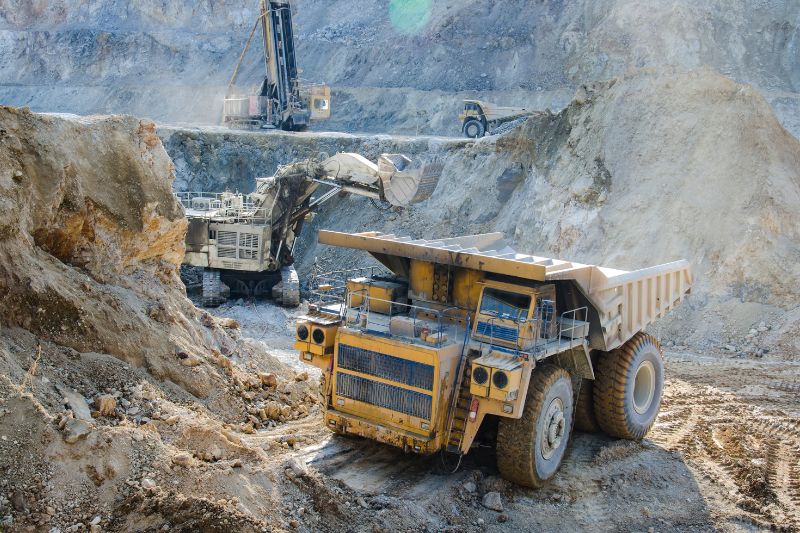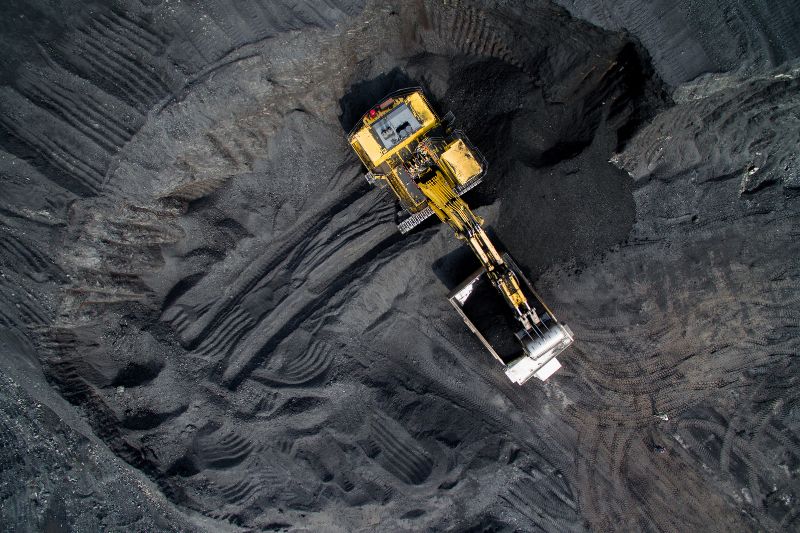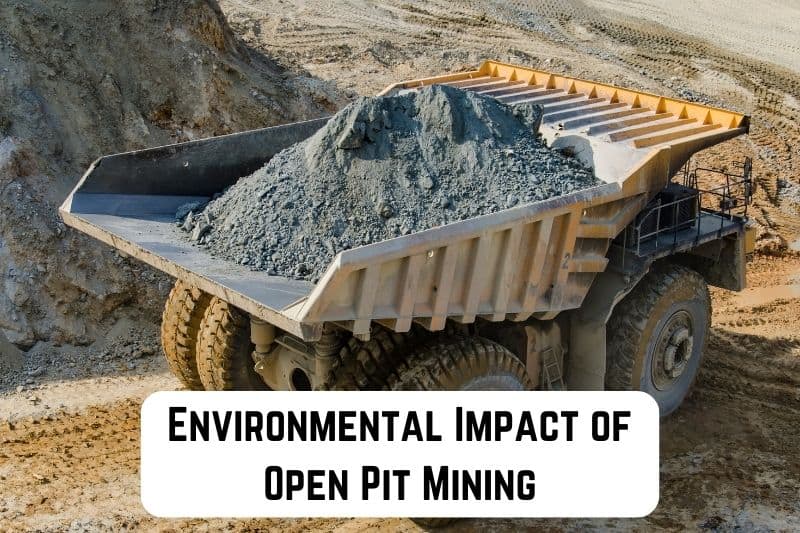Open-pit mining, just as the name suggests, is a method used to extract minerals from the Earth by creating vast open pits. This mining method basically involves the removal of layers of soil and rock to access valuable mineral deposits, typically found near the surface.
Open-pit mining, sometimes called open-cast mining, is usually applied in areas where minerals are abundant but buried at depths that necessitate extensive excavation.
Read: Can You Recycle Furnace Filters?
It is used in extracting various minerals, including:
- Copper
- Gold
- Iron
- Coal
- Bitumen
- Clay
- Gypsum
- Granite
- Marble
- Limestone
Of course, the list of minerals extracted using this method doesn’t end there. In most cases, the extracted minerals are used in industries such as construction, manufacturing, and energy production.
Now, while open-pit mining remains the most commonly used mineral extraction method, the increasing knowledge of the need to protect our planet leaves most eco-conscious minds wondering whether this method is good for the environment.
So, how does open-pit mining impact the environment? Is it good or bad for our planet, and are there any ways to make it more sustainable if at all it isn’t?
Well, these are some of the questions we will answer in this article. Herein, we’ll examine how this extraction method works, its environmental impact, safety aspects, how we can make it more sustainable, and much more. Let’s get started right away!
How Does Open-Pit Mining Work?
Now that you understand what open-pit mining is and some of the basic information surrounding it, next is how miners work the magic using this extraction method.
Just how does open-pit mining work?
Well, once it has been known that an area has valuable minerals close to the surface, within 100 meters from the earth’s surface, the process kicks off with the removal of vegetation and topsoil.
Then, large drilling rigs bore holes into the ground to create blast patterns. Explosives are carefully placed into these holes and detonated to break up the rock.
After the blasting, excavators and other heavy machinery load the broken rock into haul trucks. These trucks transport the ore to a processing plant where it is crushed, ground, and separated from waste materials. The extracted minerals are then processed further to extract the desired metals or materials.
Throughout this process, careful planning and monitoring are crucial to ensure the safety of workers and minimize environmental impacts. Once the minerals have been extracted, the pit is often backfilled with waste rock and soil, and land reclamation efforts are undertaken to restore the area as much as possible.

Environmental Impact of Open-Pit Mining
Of course, the amount of activity involved in open-pit mining doesn’t come without an impact on the environment. Right from the first extraction step to the last, open-pit mining affects the environment in several ways.
Open-Pit Mining Promotes Deforestation
As already stated, when doing open-pit mining, one initial step is to remove trees and clear any other vegetation available on the identified site. As we all know, trees play a vital role in the ecosystem, from serving as air filters to providing habitat for some creatures and keeping the soil compact to prevent erosion.
It’s especially bad to practice deforestation now because we’re worried about global warming getting worse every day. When trees are cut, and plants are removed, there are fewer places for carbon to go, so more carbon dioxide, which is a gas that makes global warming worse, stays in the air in big amounts.
Water Pollution
One significant concern is the potential for chemicals used in mining processes to leach into water sources. For instance, cyanide, a highly toxic chemical commonly used in gold mining, can pose a severe threat.
Let’s take the instance that happened in 1982 at the Zortman-Landusky Mine in Montana as an example. 52,000 gallons of cyanide solution spilled, contaminating the aquifer that supplied fresh drinking water for the town of Zortman. Such incidents highlight the risks associated with open-pit mining and its potential to contaminate vital water sources, jeopardizing human health and aquatic ecosystems.
Noise Pollution
Another environmental impact of open-pit mining that we can’t afford to ignore is noise pollution. This type of mining immensely produces lots of noise. In fact, every activity involved, from drilling and blasting to excavation, loading, and transportation, contributes to significant noise pollution.
In some cases, the noise produced is too high that it can travel considerable distances, up to 20 kilometers, depending on the machinery used and other factors. The constant noise not only disturbs wildlife but also affects nearby communities, leading to sleep disturbances, stress, and other health issues.
Air Pollution
Another environmental concern of open-cast mining is air pollution from dust particles suspended during mining operations. Exposure to this dust can lead to respiratory problems for both nearby communities and miners, particularly if they lack adequate protective equipment.
A study conducted in 2023 found that coal miners were more likely to suffer and die from respiratory diseases like lung cancer, coal workers’ pneumoconiosis (CWP), and chronic obstructive pulmonary disease (COPD).
But the threat doesn’t only emanate from the dust particles from the mining area. The emissions from the excavators, trucks, and other machinery used in the mining can contribute to polluting the air.
In fact, most of the machinery used for this process runs on fossil fuels, the leading contributor of carbon (iv) oxide, accounting for over 90% of CO2 emissions. And by the way, these fossil fuels also account for 75% of all greenhouse gasses, meaning they significantly contribute to climate change.

Is Open-Pit Mining Safe?
Open-pit mining, by its very nature, can never be entirely safe, regardless of the measures put in place. The inherent risks and challenges associated with this mining method make it nearly impossible to achieve a state of “safe mining.” While technological advancements and safety protocols have been developed to mitigate these risks, they cannot eliminate them entirely.
The primary reason open-pit mining is inherently unsafe stems from the sheer scale and scope of the operations involved.
You see, open-pit mines are massive excavations that involve the removal of large quantities of earth and rock to extract valuable minerals or resources. This process often results in significant environmental disturbances and can pose serious risks to both human safety and the surrounding ecosystem.
One of the major safety concerns associated with open-pit mining is the potential for slope failures or collapses.
The walls of open pits, technically called the batters, are typically steep and unstable, making them prone to instability and rockfalls. This poses a significant risk to not only the safety of workers and nearby communities but also the integrity of the mine itself.
Additionally, open-pit mining can have devastating environmental consequences. That’s because removing vegetation and topsoil and excavating vast land areas can lead to habitat destruction, soil erosion, and water pollution.
These environmental impacts can have far-reaching consequences for local ecosystems, biodiversity, and water resources.
But then, even though eliminating these dangers is impossible, we still can’t downplay the essence of having safety measures in place. These measures will help reduce the likelihood of the risks but won’t keep them from happening entirely.
One approach is implementing rigorous safety protocols and training programs for workers to minimize the risk of accidents and injuries. This includes a spectrum of activities, from the regular inspections of equipment and infrastructure to the use of advanced monitoring technologies to detect potential hazards.
Another approach involves having clear reclamation and rehabilitation efforts to restore mined areas to a more natural state, as well as implementing measures to control erosion and prevent pollution of air and water resources.
Innovations in technology and mining practices may also offer potential solutions for improving the safety and sustainability of open-pit mining operations.
For example, using autonomous vehicles and remote-controlled machinery can reduce the risk of accidents and injuries for workers. At the same time, advancements in waste management techniques can help minimize the environmental footprint of mining activities.
Overall, while open-pit mining presents inherent risks and challenges, proactive measures can be taken to mitigate these risks and minimize the environmental impacts. However, it is essential to recognize that complete safety and sustainability may remain elusive goals in the context of open-pit mining.
Is Open-pit Mining the Same as Strip Mining or Surface Mining?
Open-pit, strip, and surface mining are all related but distinct methods of extracting minerals from the Earth’s surface. While they all involve removing layers of soil and rock to access underlying mineral deposits, there are differences in their techniques and applications.
Let’s take open-pit mining, for instance. It involves excavating large open pits or quarries to extract valuable minerals, often using heavy machinery.
Strip mining, on the other hand, is a specific type of surface mining where layers of soil and rock are sequentially removed to access shallow deposits, typically for coal or oil sands.
As for surface mining, it’s a broader term that encompasses various methods of mining conducted on the Earth’s surface, including both open-pit and strip mining.
Read: What is Electroculture Gardening?
How to Make Open-Pit Mining More Sustainable?
To enhance the sustainability of open-pit mining, implementing practices that minimize environmental impact and maximize resource efficiency is essential. Here are some of the sustainable practices to consider:
- Efficient Resource Use: Adopting technologies for more precise extraction and waste management minimizes resource waste and environmental disturbance.
- Water Management: Implementing measures to reduce water consumption and prevent contamination of water sources mitigates environmental impacts and preserves water quality.
- Community Engagement: Involving local communities in decision-making processes and providing socio-economic benefits fosters positive relationships and ensures long-term sustainability.
- Technological Innovation: Investing in research and developing cleaner extraction methods and renewable energy sources reduces environmental footprint and enhances sustainability.
- Reclamation and Rehabilitation: This involves restoring mined areas to a natural state after the extraction. Doing this reduces habitat destruction and promotes ecosystem regeneration.
By integrating these strategies, open-pit mining operations can strive toward greater sustainability while continuing to meet resource demands.
References:
https://geo.libretexts.org/Bookshelves/Geology/Fundamentals_of_Geology_(Schulte)/12%3A_Geological_Implications/12.10%3A_Open-Pit_Mining
https://www.britannica.com/technology/mining/Surface-mining






